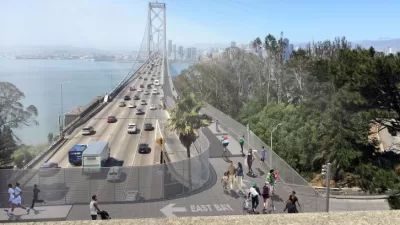One of the nation's busiest commute corridors will get a lot busier in coming decades with no large infrastructure investment in sight. SPUR has some ideas about how the East Bay to San Francisco corridor can be improved right now.
Dylan Pilaar, Erin McAuliff, and Ratna Amin report on the state, and possible future, of the Bay Area's highest-volume commute: the Bay crossing between San Francisco and the East Bay. Despite increased demand in recent years, no new transportation capacity has been added to the route since 1972. Meanwhile, transbay trips are expected to grow by 70 percent between 2015 and 2035.
"Consensus is brewing that a new transbay rail line is needed to solve the problem. A big-picture vision for a second transbay BART tube (which SPUR called for in a 2009 Report), has gained traction in recent months. A second transbay rail tube — be it for BART, standard rail like Caltrain or Amtrak, high-speed rail or a combination of the three — is essential to solving the Bay Area’s transit capacity crunch."
Such solutions, however, are likely to take decades to plan and deliver, and will not help relieve transportation crunches in the meantime. The article, written by the trio for SPUR on the Medium website, focuses on what can be done while the region works toward next big transportation investments. For a start:
"The new San Francisco Bay Area Core Capacity Transit Study, which kicks off this year, will identify short-, medium- and long-term improvements in the transbay travel corridor. The study — which involves the Metropolitan Transportation Commission, the San Francisco Municipal Transportation Agency, the San Francisco County Transportation Agency, BART, AC Transit, the Water Emergency Transportation Agency and Caltrain — will paint a clear picture of commuter travel patterns and determine how best to address the needs of Bay Area commuters."
SPUR also recommends additional measures while that study is underway, including maximizing capacity and efficiency on the BART system, adding bus lanes on the Bay Bridge and its highway approaches, deploying new demand pricing models to provide incentives for alternative modes, and several more recommendations.
FULL STORY: How Can We Move More People Between SF and the East Bay?

Trump Administration Could Effectively End Housing Voucher Program
Federal officials are eyeing major cuts to the Section 8 program that helps millions of low-income households pay rent.

Planetizen Federal Action Tracker
A weekly monitor of how Trump’s orders and actions are impacting planners and planning in America.

Ken Jennings Launches Transit Web Series
The Jeopardy champ wants you to ride public transit.

Driving Equity and Clean Air: California Invests in Greener School Transportation
California has awarded $500 million to fund 1,000 zero-emission school buses and chargers for educational agencies as part of its effort to reduce pollution, improve student health, and accelerate the transition to clean transportation.

Congress Moves to End Reconnecting Communities and Related Grants
The House Transportation and Infrastructure Committee moved to rescind funding for the Neighborhood Equity and Access program, which funds highway removals, freeway caps, transit projects, pedestrian infrastructure, and more.

From Throughway to Public Space: Taking Back the American Street
How the Covid-19 pandemic taught us new ways to reclaim city streets from cars.
Urban Design for Planners 1: Software Tools
This six-course series explores essential urban design concepts using open source software and equips planners with the tools they need to participate fully in the urban design process.
Planning for Universal Design
Learn the tools for implementing Universal Design in planning regulations.
Heyer Gruel & Associates PA
Ada County Highway District
Institute for Housing and Urban Development Studies (IHS)
City of Grandview
Harvard GSD Executive Education
Toledo-Lucas County Plan Commissions
Salt Lake City
NYU Wagner Graduate School of Public Service





























